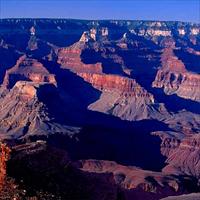US officials flood Grand Canyon to restore ecosystem

United States federal officials flushed billion of gallons of water into the Grand Canyon on Wednesday, in an experimental effort to distribute sediment throughout the river and restore the ecosystem to a more natural state.
The water was released from two pipes in the controversial Glen Canyon Dam, which blocks the Colorado River and creates the artificial reservoir Lake Powell. At a rate of more than 300,000 gallons of water per second, the flood could fill up the 102-story Empire State Building in 20 minutes, said Interior Secretary Dirk Kempthorne.
"This gives you a glimpse of what nature has been doing for millions of years, cutting through and creating this magnificent canyon," Kempthorne said after pulling the lever that released the water. The flood will continue for 60 hours, during which time the flow of water from the dam is expected to increase by four or five times.
After the dam was built in 1963, the seasonal floods that would spread sediment throughout the river were halted. This sediment was necessary for creating sandbars and beaches, which served as wildlife habitats. As a result, two fish species have become extinct, and two others have become endangered, including the humpback chub. Although the water level will only rise a few feet after the flood, officials are hoping it will be enough to restore eroded sandbars downstream.
Scientists will be conducting studies on how the flooding affects the native species and their habitats. "Our ultimate purpose is to learn whether or not this is a viable strategy for creating sandbars and habitats for native fish," said John Hamill, chief of the Grand Canyon Monitoring and Research Center.
Similar experiments were conducted in 1996 and 2004, although Randall Peterson, an environmental manager for the Bureau of Reclamation, says, "Those conditions were markedly different." He says that tributaries below the dam have released high volumes of sediment in recent years, making conditions more favorable.
However, environmentalists from the Grand Canyon Trust, which has often criticized the government's management of the dam, say there is more that can be done. They assert that the floods must occur regularly if any real change is to be expected, and they accuse the government of conducting the experiment for show. "They're trying to make it appear that they're doing something beneficial when they're just doing it for appearances," said Nikolai Lash, senior program director for the Trust. "It's being manipulated to be a 'one and done,' even though we know that doesn't work."
Grand Canyon National Park superintendent Steve Martin also raised concerns about the project. He said that not following up with more floods soon could actually destroy habitats rather than restoring them. Though the federal plan calls for smaller annual flows in autumn, Martin says these were timed to serve the interests of hydroelectric power producers.
"The best time to get the most money for your hydropower is during peak energy demands, which is generally daytime hours and generally in the summer," Martin said. The U.S. Geological Survey acknowledged that the timing was partly designed in order to maximize electricity production during peak demand.
Meanwhile, others are simply unhappy with the arguing and indecision that have plagued the issue. Martha Hahn, science center director at the national park, said, "At some point we're going to have to draw a line in the sand and say this is the best way to manage the dam and manage resources in the Grand Canyon. We can't continue to go on and on just researching. We have to make a decision. We really are losing valuable resources."
 Back and Next - Back and Next
Back and Next - Back and Next See Also - See Also
See Also - See Also